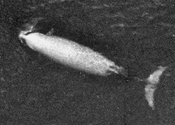Ziphiidae
| Beaked whale Temporal range: Miocene–Recent |
|
|---|---|
 |
|
| Ziphius cavirostris | |
| Scientific classification | |
| Kingdom: | Animalia |
| Phylum: | Chordata |
| Class: | Mammalia |
| Order: | Artiodactyla |
| Infraorder: | Cetacea |
| Superfamily: | Ziphioidea |
| Family: |
Ziphiidae Gray, 1850 |
| Genera | |
|
|
Beaked whales are the members of the family Ziphiidae, which consists of 22 species. These toothed whales are notable for their elongated beaks. Among air-breathing animals, beaked whales are some of the most extreme divers: Cuvier's beaked whales regularly dive for an hour at a depth over 1,000 m (3,300 ft), and the longest and deepest foraging dive recorded is 137.5 minutes at 2,992 m (9,816 ft). This is the greatest dive-depth known for a mammal.
Beaked whales are one of the least known groups of mammals because of their deep-sea habitat, mysterious habits, and apparent low abundance. Only three to four of the 22 species are reasonably well-known. Baird's and Cuvier's beaked whales were subject to commercial exploitation, off the coast of Japan, while the northern bottlenose whale was extensively hunted in the northern part of the North Atlantic late in the 19th and early 20th centuries.
Due to the fact that the vast majority of their behavior is something of an enigma to the scientific community, beaked whales live very short lives in captivity when compared to other cetaceans like common bottlenose dolphins and short-finned pilot whales, barely making it past a single day out of the ocean. The longest time period for a beaked whale living in captivity was 25 days. Alexander and Nicholas who were two male beaked whales, their species is currently unknown, had become stranded in California on August 24, 1989 were eventually taken to Marine World California. Both of the whales eventually died of pneumonia, but Nicholas died on 8 September whereas Alexander died 10 days later. A few news sources did cover the death of these whales.
Beaked whales are moderate in size, ranging from 4 to 13 metres (13 to 43 ft) and weighing from 1 to 15 tonnes (0.98 to 14.76 long tons; 1.1 to 16.5 short tons). Their key distinguishing feature is the presence of a 'beak', somewhat similar to many dolphins. Other distinctive features include a pair of converging grooves under the throat, and the absence of a notch in the tail . Although Shepherd's beaked whale is an exception, most species have only one or two pairs of teeth, and even these do not erupt in females. Beaked whale species are often sexually dimorphic – one or the other sex is significantly larger. The adult males often possess a dramatically bulging forehead. However, aside from dentition and size, very few morphological differences exist between male and female beaked whales.
...
Wikipedia
